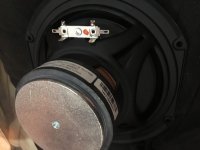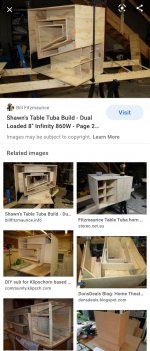Back almost exactly twenty years ago I made some subwoofers with Ultimate brand subwoofer drivers. They were moderate power (c. 120wrms, decently magneted (c. 40oz), and high compliance (Fs c. 30Hz).
Lately I've been wanting to remake similar subs. However, I was having trouble finding 8" subwoofer drivers like the old Ultimates. The price for the Tang Band ones are about $85 more than the Ultimates were, $115 and $30, respectively. I don't think many items have quadrupled in price like that in 20 years.
Lately I've been wanting to remake similar subs. However, I was having trouble finding 8" subwoofer drivers like the old Ultimates. The price for the Tang Band ones are about $85 more than the Ultimates were, $115 and $30, respectively. I don't think many items have quadrupled in price like that in 20 years.
For multiple subs in a room (even stereo, if the crossover is below maybe 130 Hz), you really want heterogeneity not matching. I know that opinion will irritate many people who cherish uniformity as value itself in life and audio.
B.
B.
Electrone,Lately I've been wanting to remake similar subs. However, I was having trouble finding 8" subwoofer drivers like the old Ultimates.
Without more parameters to go on than Fs, hard to say what might be comparable to the "old Ultimates".
The
Dayton Audio SD215A-88 8" DVC Subwoofer
has an Fs 31Hz at $29.98, a price similar to what you paid 20 years ago.
6mm Xmax and 7.7BL is still a good deal for a woofer of that cost.
The Tang Band W8-740P 8" Subwoofer has a 30Hz Fs, about double the Xmax, and BL, but at $112.63 almost four times the cost.
I've found these are nice for small 8", for less than 100W. I constructed a couple ported boxes, Fc=25Hz. I just needed something to cover the low band below 45Hz, to complement the old (re-surrounded😛) Advent Towers that I have.  .
.
S-O M2-8S*C
 .
.S-O M2-8S*C
$29.99 MCM/Newark 55-2421, similar TB horn driver specs except 'only' 8 mm Xmax: https://www.newark.com/mcm-audio-se...U-MDC-OPTOELECTRONICS_LED_LIGHTING_COMPONENTS
$29.99 MCM/Newark 55-2421, similar TB horn driver specs except 'only' 8 mm Xmax: https://www.newark.com/mcm-audio-se...U-MDC-OPTOELECTRONICS_LED_LIGHTING_COMPONENTS
Whoa! Have you used this or have any suggested /experience with the use of specifically?
I think that McM one (two) justifies the use of ‘spending money’ for the month February? Last time it was a few of these for fun:
Peerless by Tymphany SDS-160F25PR01-08 6-1/2" Paper Cone Woofer Speaker
Last edited:
CBS240, only twice as much cost, so that helps. But good how the surrounds are rubber like the Ultimates were.
GM, I think your find might be the closest substitute. A difference is the Ultimates had rubber surrounds instead of foam. My memory seems to be that the Xmax of the Ultimates was 12mm. I noticed on the Ultimates though, the braided wires between the lug terminals and the cones tended to hit the cone during wide excursions. So a little judicious repositioning of the braided wires fixed that.
Booger weldz, the smaller size of 6 1/2" doesn't match the 8" diameters of the Ultimates. Not too bad, though. I like the Peerless you linked to having the sealed box recommendation.
The small size of those Peerless would enable them to fit in enclosures made out of concrete building blocks. That's about as stiff as you can get for enclosure walls. I actually made a pair of speakers like that.
I had put my Ultimates in a cabinet that was smaller than normal. I put two in about a 1 cubic ft. box, whereas each driver was recommended to be in a one cubic ft. box.
I had figured on trying to eliminate enclosure resonance from the frequency response curve. Thus undersized boxes stuffed with poly batting. I had two woofers in about a 1 cubic ft. box, one on the front, and one on the back. I sat directly in front of the sub box, on the floor. It was nice feeling the bass and its attack.
I used free Fifa box design software, so that once box volume, power input, and suitable T/S parameters were entered, the response curve would be plotted, dB on the vertical axis, frequency on the horizontal axis. I entered a small box volume so that the box frequency and the box -3dB points were both above the crossover point of the crossover filter.
After building boxes and when using them, I added heavy equalization to counteract the steady decline of the speaker-in-enclosure output vs frequency. Results: I thought the bass reproduction sounded tight and clean. It takes a lot of amplifier power though.
A thought occurred to me when reading threads about more conventionally-sized boxes that have the -3dB frequency and the box frequency below the crossover point. The damping factor of the amplifier and speaker wire combination is important to consider in controlling the speaker cone position. Fortunately, I think most modern amplifiers have damping factors around 50 or higher.
GM, I think your find might be the closest substitute. A difference is the Ultimates had rubber surrounds instead of foam. My memory seems to be that the Xmax of the Ultimates was 12mm. I noticed on the Ultimates though, the braided wires between the lug terminals and the cones tended to hit the cone during wide excursions. So a little judicious repositioning of the braided wires fixed that.
Booger weldz, the smaller size of 6 1/2" doesn't match the 8" diameters of the Ultimates. Not too bad, though. I like the Peerless you linked to having the sealed box recommendation.
The small size of those Peerless would enable them to fit in enclosures made out of concrete building blocks. That's about as stiff as you can get for enclosure walls. I actually made a pair of speakers like that.
I had put my Ultimates in a cabinet that was smaller than normal. I put two in about a 1 cubic ft. box, whereas each driver was recommended to be in a one cubic ft. box.
I had figured on trying to eliminate enclosure resonance from the frequency response curve. Thus undersized boxes stuffed with poly batting. I had two woofers in about a 1 cubic ft. box, one on the front, and one on the back. I sat directly in front of the sub box, on the floor. It was nice feeling the bass and its attack.
I used free Fifa box design software, so that once box volume, power input, and suitable T/S parameters were entered, the response curve would be plotted, dB on the vertical axis, frequency on the horizontal axis. I entered a small box volume so that the box frequency and the box -3dB points were both above the crossover point of the crossover filter.
After building boxes and when using them, I added heavy equalization to counteract the steady decline of the speaker-in-enclosure output vs frequency. Results: I thought the bass reproduction sounded tight and clean. It takes a lot of amplifier power though.
A thought occurred to me when reading threads about more conventionally-sized boxes that have the -3dB frequency and the box frequency below the crossover point. The damping factor of the amplifier and speaker wire combination is important to consider in controlling the speaker cone position. Fortunately, I think most modern amplifiers have damping factors around 50 or higher.
Last edited:
Weltersys, I recall that less strong magnetic field on the voice coil tends to lower the frequency response of a driver, at the expense of sensitivity. I was looking at low cost OEM woofers for replacements for stereo systems intended for the average consumer, and the frequency response figures looked relatively good for producing deep bass. However, the Bl figures tend to be around 7, whereas higher grade woofers tend to be 12 or more.
Cinder block speakers sounds like a fun project, especially for a small sealed and precise sound from the right drivers and qts/ qtc!
Indeed, puts a literal aspect to the saying, rock solid bass! Just have to be sure to pack in the poly fill.
Last edited:
Back almost exactly twenty years ago I made some subwoofers with Ultimate brand subwoofer drivers. They were moderate power (c. 120wrms, decently magneted (c. 40oz), and high compliance (Fs c. 30Hz).
Lately I've been wanting to remake similar subs.
I remember the old Ultimates. Used them a lot in the 90’s. They were designed to get the maximum useable bass out of 1 or 2 hundred watts, good for both home and car. Drivers with similar parameters have just about disappeared entirely due to the direction that the markets have taken, unfortunately. Dayton series 2 (by Eminence) was a good replacement, while they lasted. But ultimately they too went away. Everything made now with remotely similar tuning is about 6dB less sensitive and costs about 4X. 85 dB 1m/1W is the rule of the day now, not 90 to 92. You can also buy Chinese junk with no motor strength for around the same money as the older Ultimates, but they aren’t any more sensitive and are very peaky and can’t be used in vented boxes.
The problem with those older drivers is that they were sensitive enough that you could bottom them out easily with 3 or 4 hundred watts in vented alignments that produced A LOT of bass. Limited by excursion, both linear and absolute maximum. Markets demanded something different, and unfortunately responded. Can’t even find Eminence drivers that are similar anymore.
Indeed, puts a literal aspect to the saying, rock solid bass! Just have to be sure to pack in the poly fill.
Youre a bad influence! 🙂 These magnet/motor parts and narrow open frame sneak into the gap on a retaining wall (raised garden area
Of concrete blocks in the back yard) just fine. It started pisssing rain or id have gotten the phone and a pic...
Attachments
wg_ski, nice to reminisce with you. The high efficiency helped me because my box size had fb above the crossover point
Booger weldz,
Booger weldz,
that's the impression I've gotten for quite a while now.Youre a bad influence!
Cut it open, lets see the guts! 🙂
The 2nd link supposed take you to the guts.
But, here ya go!
Attachments
Wow, that's a long, complicated path. I could probably BOXPLAN it if had some time on my hands, but I expect that there'd be no easy way to derive a corresponding Hornresp sim for it. Too many differently-expanding segments. I might be able to get close though, if given a measured impedance curve and frequency response graph to work with.
- Home
- Loudspeakers
- Subwoofers
- Tang, like the old Ultimate


